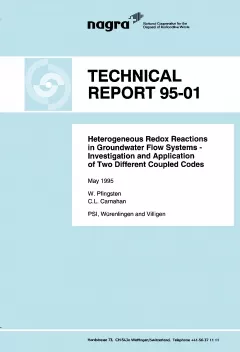
Technical Report NTB 95-01
Heterogeneous Redox Reactions in Groundwater Flow Systems Investigation and Application of Two Different Coupled Codes
Two simulators of reactive chemical transport are applied to a set of problems involving heterogeneous redox reactions of uranium species. The simulators use similar algorithms to compute the heterogeneous chemical equilibria, but they use distinctly different approaches to the computation of solute transport and to the coupling of transport with chemical reactions. One simulator (MCOTAC) sequentially couples calculations of static chemical equilibria to a random-walk simulation of solute advection and dispersion. The other simulator (THCC) directly couples mass action relations for chemical equilibria to finite difference representations of the solute transport equations.
The aim of the comparison was to demonstrate the applicability of the newly developed code MCOTAC to redox problems, and to identify and investigate general differences between the two types of codes within these applications. The chosen heterogeneous redox systems are hypothetically generated systems which provide numerical difficulties within the coupled code calculation. Uranium, an important component of heterogeneous redox systems consisting of uraniferous solids and natural groundwaters, was chosen as a main component in the example redox systems because of practical interest for performance assessment of geological repositories for nuclear wastes.
The calculations show reasonable agreement, in general, between the two computational approaches. Specific areas of disagreement arise from numerical difficulties peculiar to each approach. Such "benchmarking" can enhance confidence in the overall performance of individual simulators while identifying aspects that may require further investigations and possible modifications.
